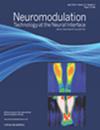评估脊髓刺激作为乳房切除术后疼痛综合征的治疗策略:回顾性观察研究
IF 3.2
3区 医学
Q2 CLINICAL NEUROLOGY
引用次数: 0
摘要
背景:乳腺癌切除术后疼痛综合征(PMPS)是一种严重影响乳腺癌幸存者的慢性疾病,其特征是持续性神经病理性疼痛,通常对传统疗法无反应。脊髓刺激(SCS)已成为一种治疗此类疼痛的有效干预方法。本研究旨在评估脊髓刺激治疗在控制PMPS方面的临床疗效,并确定影响治疗结果的患者特异性因素:这项回顾性观察研究分析了 2023 年 1 月至 10 月间接受 SCS 植入术的 78 名女性患者。通过评估视觉模拟量表(VAS)疼痛评分从基线到植入后 6 个月的变化来评估 SCS 的疗效。采用二元逻辑回归法探讨了年龄、体重指数(BMI)、既往治疗情况和心理健康状况等因素对治疗成功率的影响:结果:植入手术六个月后,61 名患者(78.2%)报告疼痛明显缓解,VAS 评分下降≥4 分。统计分析显示,有几项因素可预测积极的结果:年龄较小(危险比 [HR] = 0.882,95% CI:0.802-0.970,p = 0.009)、体重指数较低(HR = 0.659,95% CI:0.487-0.891,p = 0.007)和心理治疗(HR = 0.015,95% CI:0.001-0.377,p = 0.011)。相反,之前接受过放疗的患者预后较差(HR = 2.139,95% CI:1.219-5.808,p = 0.029)。接受者操作特征曲线分析证实了该模型的准确性(曲线下面积 = 0.927):SCS是治疗PMPS的有效方法,年龄、体重指数、心理治疗和之前的放疗是预测疗效的重要因素。根据这些因素调整治疗方案有可能加强对 PMPS 患者的疼痛管理。本文章由计算机程序翻译,如有差异,请以英文原文为准。
Evaluating Spinal Cord Stimulation as a Therapeutic Strategy for Postmastectomy Pain Syndrome: A Retrospective Observational Study
Background
Postmastectomy pain syndrome (PMPS) is a chronic condition that significantly impacts breast cancer survivors, marked by persistent neuropathic pain that is often unresponsive to conventional therapies. Spinal cord stimulation (SCS) has emerged as a promising intervention for managing this type of pain. This study aimed to assess the clinical efficacy of SCS in managing PMPS and identify patient-specific factors impacting treatment outcomes.
Materials and Methods
This retrospective observational study analyzed 78 female patients who underwent SCS implantation between January and October 2023. The efficacy of SCS was assessed by evaluating changes in visual analog scale (VAS) pain scores from baseline to six months after implantation. The influence of factors such as age, body mass index (BMI), prior treatments, and psychologic health on treatment success was explored using binary logistic regression.
Results
Six months after implantation, 61 patients (78.2%) reported significant pain relief, with a decrease in VAS scores by ≥4 points. Statistical analysis revealed several predictors of positive outcomes: younger age (hazard ratio [HR] = 0.882, 95% CI: 0.802–0.970, p = 0.009), lower BMI (HR = 0.659, 95% CI: 0.487–0.891, p = 0.007), and psychologic treatment (HR = 0.015, 95% CI: 0.001–0.377, p = 0.011). Conversely, prior radiotherapy was associated with less favorable outcomes (HR = 2.139, 95% CI: 1.219–5.808, p = 0.029). The receiver operating characteristic curve analysis confirmed the model’s accuracy (area under the curve = 0.927).
Conclusions
SCS is an effective treatment for PMPS, with age, BMI, psychologic treatments, and prior radiotherapy being significant predictors of outcomes. Tailoring treatment plans to these factors can potentially enhance pain management for patients with PMPS.
求助全文
通过发布文献求助,成功后即可免费获取论文全文。
去求助
来源期刊

Neuromodulation
医学-临床神经学
CiteScore
6.40
自引率
3.60%
发文量
978
审稿时长
54 days
期刊介绍:
Neuromodulation: Technology at the Neural Interface is the preeminent journal in the area of neuromodulation, providing our readership with the state of the art clinical, translational, and basic science research in the field. For clinicians, engineers, scientists and members of the biotechnology industry alike, Neuromodulation provides timely and rigorously peer-reviewed articles on the technology, science, and clinical application of devices that interface with the nervous system to treat disease and improve function.
 求助内容:
求助内容: 应助结果提醒方式:
应助结果提醒方式:


